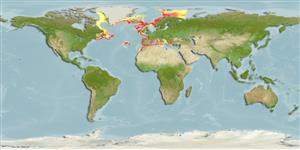Preferred temperature (Ref.
123201): 2.1 - 14.1, mean 6.3 °C (based on 199 cells).
Índice de diversidade filogenética (Ref.
82804): PD
50 = 0.6562 [Uniqueness, from 0.5 = low to 2.0 = high].
Bayesian length-weight: a=0.00302 (0.00171 - 0.00533), b=3.03 (2.87 - 3.19), in cm total length, based on LWR estimates for this species & (Sub)family-body (Ref.
93245).
Nível Trófico (Ref.
69278): 4.5 ±0.6 se; based on diet studies.
Resiliência (Ref.
120179): Baixo, tempo mínimo de duplicação da população 4,5 - 14 anos (K=0.13-0.16; tm=8-11; tmax=20).
Prior r = 0.31, 95% CL = 0.20 - 0.46, Based on 3 full stock assessments.
Fishing Vulnerability (Ref.
59153): Very high vulnerability (75 of 100).
🛈
Climate Vulnerability (Ref.
125649): Moderate to high vulnerability (47 of 100).
🛈
Nutrients (Ref.
124155): Calcium = 16.4 [8.1, 35.6] mg/100g; Iron = 0.278 [0.142, 0.592] mg/100g; Protein = 17.6 [15.8, 19.3] %; Omega3 = 0.381 [0.204, 0.707] g/100g; Selenium = 29.8 [15.2, 59.6] μg/100g; VitaminA = 10.9 [2.7, 40.8] μg/100g; Zinc = 0.305 [0.198, 0.473] mg/100g (wet weight);
